Special Feast Days
 |
 |
 |
 |
 |
 |
 |
Feast of the Holy Relics - November 5
Selection by Dom Gueranger:
In the 16th century the heresy that profaned the graves of the Saints pretended to abolish the cult to the relics. Opposing those most evil Protestant reformers, the Council of Trent, expressing the unanimous testimony of Tradition, issued the following definition that summarized the theological reasons for the cult the Church gives to the relics of the Saints:
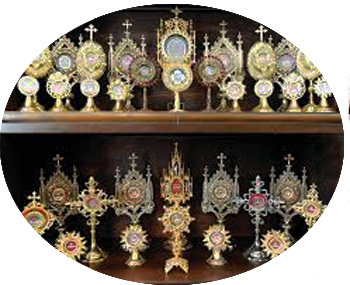 "The faithful must venerate the bodies of the Martyrs and other Saints now living with Christ – whose bodies were the living members of Christ and the temple of the Holy Ghost, and are to be raised by Him unto eternal life, and through whose bodies many benefits are bestowed by God on men.
"The faithful must venerate the bodies of the Martyrs and other Saints now living with Christ – whose bodies were the living members of Christ and the temple of the Holy Ghost, and are to be raised by Him unto eternal life, and through whose bodies many benefits are bestowed by God on men.
"So that they who affirm that veneration and honor are not due to the relics of saints; or, that these and other sacred monuments are uselessly honored by the faithful; and that the places dedicated to the memories of the saints are in vain visited with the view of obtaining their aid; are wholly to be condemned, as the Church has already long since condemned (Council of Nicaea (IIc.VII), and now also condemns them." (Session 25)
Comments of Prof. Plinio:
You see, therefore, that the reasons for the cult to the relics are:
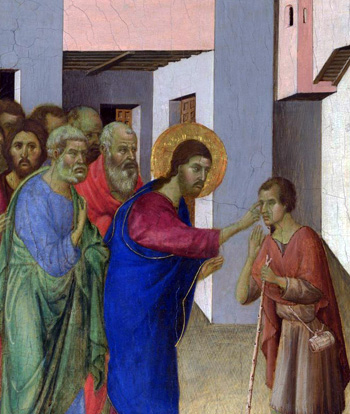 To understand the value, let us consider the Body of Our Lord Jesus Christ.
To understand the value, let us consider the Body of Our Lord Jesus Christ.
Our Lord Jesus Christ has the Body of a true man. When He was on earth, His Body was so sacrosanct that anything His Body touched worked marvels. With His simple saliva He cured a blind man (Jn 9:6; Mk 7:31-37, 8:22-26); with the touch of His hands He cured countless persons; by fixing His gaze on someone – St. Peter for example – He worked marvelous conversions.
When His Precious Blood fell upon the soldier Longinus who had pierced His Heart; that Blood cured him of almost total blindness and removed his soul from the hardened state it was in. This shows that the most holy Body of Our Lord has such a deep liaison with His Soul and Divinity that, in Him, His Blood, Body, Soul and Divinity constituted one single whole that cannot be separated.
In this way we can understand the relationship between the body and soul. Our body is not something extrinsic to us in which we are accidentally placed in a transitory way; rather, it is an essential part of our being. For this reason, our souls animate our bodies so long as the body and the soul are together. When a man dies his soul is not present in his relics, but the soul nonetheless conserves some relationship with those relics.
The relics that we venerate – pieces of bones, strands of hair or ashes of canonized Saints – will be reincorporated to the bodies of those Saints when they resurrect. So then, these relics that belonged to a body that was a temple of the Holy Spirit, that were linked to a soul which had the supernatural live of grace, that received the Sacraments, practiced acts of piety, courage, heroism, combativeness and dedication, these relics will be reincorporated to their resurrected body when the Angels blow their trumpets calling all men to the Final Judgment.
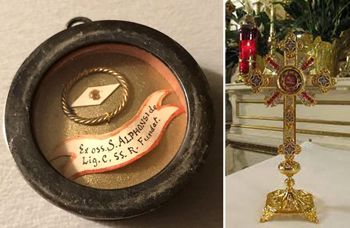 We have the certainty that these relics, which we now venerate in a crystal shrine, will one day enjoy the glory of Paradise close to God.
We have the certainty that these relics, which we now venerate in a crystal shrine, will one day enjoy the glory of Paradise close to God.
You can understand that it is reasonable that these relics should be the channel of important graces from God; that when we touch them or pray close to them, we obtain special graces from the Saints to whom they belonged, and that they somehow bring the presence of those Saints into our midst.
We should, thus, have the greatest respect for these relics and also great confidence in the intercession of the Saints to whom they belong. By a disposition of Divine Providence these relics are among us. That same Providence desires that we pray to these Saints in order to attain the favors we need.
This is, then, a stimulus for you to frequent our chapel and venerate the relics in this reliquary, which was brought here for this evening.
There are three types of relics: first, second and third class relics. The Church defines first class relics as parts of the body or ashes of a Martyr or a Saint. These relics are in small glass-covered circular cases boxes called thecas. Each relic has a document issued by the Church proving and assuring its authenticity. The relics that we have at our chapel came from the proper organ of the Vatican.
Then there are second-class relics, which are items owned or used by a Saint. These relics carry with them a blessing, which in turn is transmitted to those who touch and venerate them.
The third class relics are objects that have been touched to a first or second-class relic.
For example, here we have this fabric of red silk, which is the Mantle used by the great Card. Merry del Val, who was the Secretary of St. Pius X. This Mantle was given to us – I was present at the moment of the delivery – by the Procurator of his Cause for Canonization, who authenticated its origin with a written text placed at the bottom of the Mantle itself.
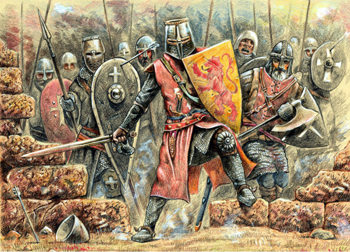 So, if any of you would like to ask a grace for the Card. Merry del Val, you should pray to him close to his Mantle, and even touching it if you like.
So, if any of you would like to ask a grace for the Card. Merry del Val, you should pray to him close to his Mantle, and even touching it if you like.
Someone could ask me: What is the relationship between the relics of the Saints and the combativeness that a counter-revolutionary must have?
I answer: The medieval warriors used to take relics into battle. It was a custom to put a relic in the pommel of the sword so that as they fought, they would wield the relics to defend their cause in the battle. If they were wounded and were in risk of dying, they would kiss the relics in their swords, asking the protection of the Saints should they die.
You see, therefore, how the spirit of combativeness is akin to the cult of the relics. We should ask the Saints for the grace and strength to duly combat our revolutionary enemies.
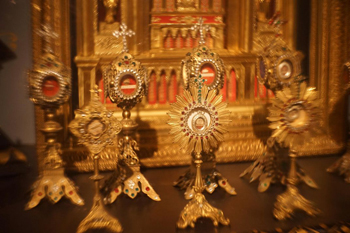


The Saint of the Day features highlights from the lives of saints based on comments made by the late Prof. Plinio Corrêa de Oliveira. Following the example of St. John Bosco who used to make similar talks for the boys of his College, each evening it was Prof. Plinio’s custom to make a short commentary on the lives of the next day’s saint in a meeting for youth in order to encourage them in the practice of virtue and love for the Catholic Church. TIA thought that its readers could profit from these valuable commentaries.
The texts of both the biographical data and the comments come from personal notes taken by Atila S. Guimarães from 1964 to 1995. Given the fact that the source is a personal notebook, it is possible that at times the biographic notes transcribed here will not rigorously follow the original text read by Prof. Plinio. The commentaries have also been adapted and translated for TIA’s site.
In the 16th century the heresy that profaned the graves of the Saints pretended to abolish the cult to the relics. Opposing those most evil Protestant reformers, the Council of Trent, expressing the unanimous testimony of Tradition, issued the following definition that summarized the theological reasons for the cult the Church gives to the relics of the Saints:

Catholics venerate relics of the Saints
"So that they who affirm that veneration and honor are not due to the relics of saints; or, that these and other sacred monuments are uselessly honored by the faithful; and that the places dedicated to the memories of the saints are in vain visited with the view of obtaining their aid; are wholly to be condemned, as the Church has already long since condemned (Council of Nicaea (IIc.VII), and now also condemns them." (Session 25)
Comments of Prof. Plinio:
You see, therefore, that the reasons for the cult to the relics are:
- The souls of the Saints live with Jesus Christ;
- Their bodies were temples of the Holy Spirit;
- The relics are part of their bodies, which will resurrect to enjoy eternal life and glory.

Our Lord cures the blind man with his saliva
Our Lord Jesus Christ has the Body of a true man. When He was on earth, His Body was so sacrosanct that anything His Body touched worked marvels. With His simple saliva He cured a blind man (Jn 9:6; Mk 7:31-37, 8:22-26); with the touch of His hands He cured countless persons; by fixing His gaze on someone – St. Peter for example – He worked marvelous conversions.
When His Precious Blood fell upon the soldier Longinus who had pierced His Heart; that Blood cured him of almost total blindness and removed his soul from the hardened state it was in. This shows that the most holy Body of Our Lord has such a deep liaison with His Soul and Divinity that, in Him, His Blood, Body, Soul and Divinity constituted one single whole that cannot be separated.
In this way we can understand the relationship between the body and soul. Our body is not something extrinsic to us in which we are accidentally placed in a transitory way; rather, it is an essential part of our being. For this reason, our souls animate our bodies so long as the body and the soul are together. When a man dies his soul is not present in his relics, but the soul nonetheless conserves some relationship with those relics.
The relics that we venerate – pieces of bones, strands of hair or ashes of canonized Saints – will be reincorporated to the bodies of those Saints when they resurrect. So then, these relics that belonged to a body that was a temple of the Holy Spirit, that were linked to a soul which had the supernatural live of grace, that received the Sacraments, practiced acts of piety, courage, heroism, combativeness and dedication, these relics will be reincorporated to their resurrected body when the Angels blow their trumpets calling all men to the Final Judgment.

First class relic: a piece of bone of St. Alphonsus in a theca; second class relic: a piece of the veil of Our Lady in an elaborate reliquary
You can understand that it is reasonable that these relics should be the channel of important graces from God; that when we touch them or pray close to them, we obtain special graces from the Saints to whom they belonged, and that they somehow bring the presence of those Saints into our midst.
We should, thus, have the greatest respect for these relics and also great confidence in the intercession of the Saints to whom they belong. By a disposition of Divine Providence these relics are among us. That same Providence desires that we pray to these Saints in order to attain the favors we need.
This is, then, a stimulus for you to frequent our chapel and venerate the relics in this reliquary, which was brought here for this evening.
There are three types of relics: first, second and third class relics. The Church defines first class relics as parts of the body or ashes of a Martyr or a Saint. These relics are in small glass-covered circular cases boxes called thecas. Each relic has a document issued by the Church proving and assuring its authenticity. The relics that we have at our chapel came from the proper organ of the Vatican.
Then there are second-class relics, which are items owned or used by a Saint. These relics carry with them a blessing, which in turn is transmitted to those who touch and venerate them.
The third class relics are objects that have been touched to a first or second-class relic.
For example, here we have this fabric of red silk, which is the Mantle used by the great Card. Merry del Val, who was the Secretary of St. Pius X. This Mantle was given to us – I was present at the moment of the delivery – by the Procurator of his Cause for Canonization, who authenticated its origin with a written text placed at the bottom of the Mantle itself.

Crusaders often had relics embedded in their swords
Someone could ask me: What is the relationship between the relics of the Saints and the combativeness that a counter-revolutionary must have?
I answer: The medieval warriors used to take relics into battle. It was a custom to put a relic in the pommel of the sword so that as they fought, they would wield the relics to defend their cause in the battle. If they were wounded and were in risk of dying, they would kiss the relics in their swords, asking the protection of the Saints should they die.
You see, therefore, how the spirit of combativeness is akin to the cult of the relics. We should ask the Saints for the grace and strength to duly combat our revolutionary enemies.


 | |
|
|
The texts of both the biographical data and the comments come from personal notes taken by Atila S. Guimarães from 1964 to 1995. Given the fact that the source is a personal notebook, it is possible that at times the biographic notes transcribed here will not rigorously follow the original text read by Prof. Plinio. The commentaries have also been adapted and translated for TIA’s site.


